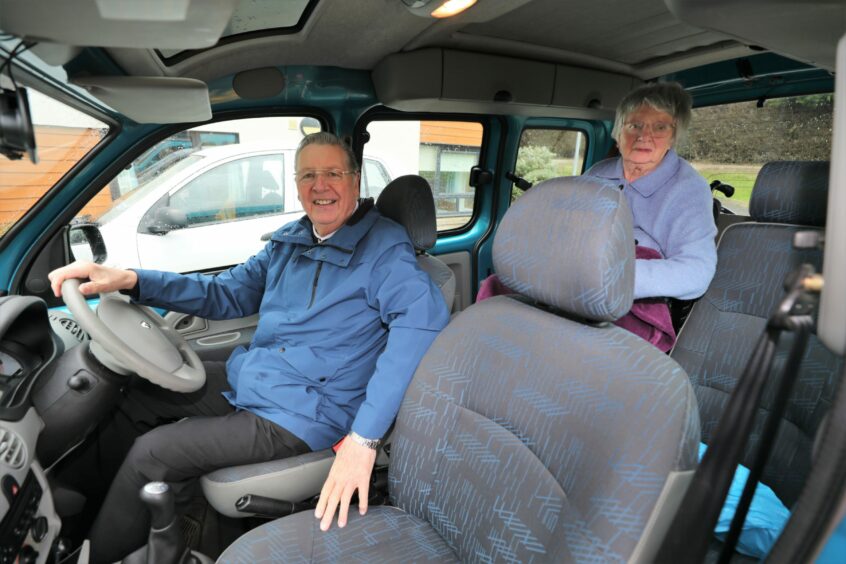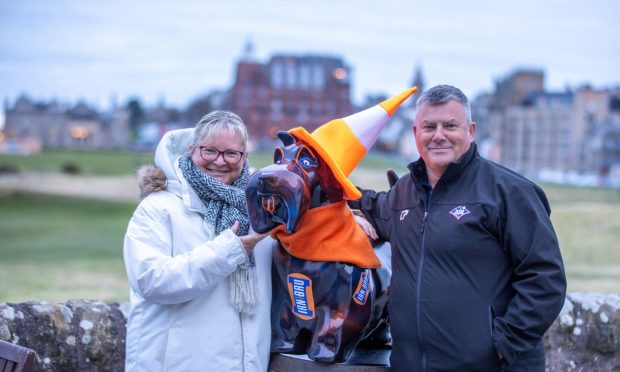A Dundee man who funded his own Wheelchair Accessible Vehicle to take his wife out of her care home says it’s time for a rethink on patient transportation.
Jack Reilly says Joan’s care at Balhousie St Ronan’s in Dundee is good, and her health has also stabilised since he’s been taking her out and about locally.
But getting transport has been a battle because Joan didn’t qualify for Motability and care staff can no longer help lift patients into cars.
Now, Jack is calling for the Scottish Government to take a fresh look at possibilities around patient transfer and Wheelchair Accessible Vehicles (WAVs), as ambulance services remain under pressure.
Jack, 82, explains: “There are two parts to this. One is the long waits and often cancellations with patient transport to and from hospital appointments.
“Patients at nursing homes usually attend hospital appointments and I’ve heard about problems with the use of ambulances for patient transfer.
“When the home books them sometimes they don’t turn up or are late.
“It means the home having to cancel appointments at short notice and we know what the health service is saying about people not turning up for appointments.”
The other point, Jack says, is the effect on people of being in a care home all day.
WAVs could help patients and NHS
“Being inside, looking at four walls, does not help patients’ health and wellbeing, which impacts the NHS too.”
He believes government-funded WAVs for care homes could help patients and their families, and ease pressure on health services.
Jack explains: “I see my wife every day. She can’t come home because we have stairs in the house but we go out in the car together.
“She enjoys seeing people and it keeps her going. It has helped her health, she has not deteriorated to what she may have otherwise.
Joan, 81, and Jack married almost 60 years ago and had two daughters and a son.
“Joan has had diabetes since 2000 and began (showing) signs of dementia in 2016,” says Jack.
‘Homes are doing their best’
“I was coping reasonably well at home but when my son died Joan gradually became worse.”
After a couple of falls and hospitalisation during Covid, Joan struggled to walk or stand.
“They put it down to her dementia but I think it could be the lack of physio because she was still able to communicate very clearly,” Jack explains.
“The home are doing their very best for her. She’s been there since October 2020.”
Waiting lists and expense of WAVs
At first, Jack was able to take Joan out in a normal car, with staff helping to get her in. But both he and his daughter sustained injuries lifting Joan and had to stop.
“I’ve seen other families trying to lift loved ones into a private car and I feel for them,” adds Jack.
Buying a WAV was Jack’s only remaining option, he felt, if he wanted to take Joan out.
“We go to Gracie’s cafe in the Ferry to meet family and friends, Dobbies, or some Downfield Musical Society shows.”
Waiting lists for mobility access cars are long and WAVS are expensive.
Jack explains: “The government, for people under pension age, pays for the basic car.
“The patient then pays for the modifications (to WAV). The basic car is, say, £21-£22k, new. And then £1,900-£3,500 for the modification.
‘Price he’d get from someone desperate’
“One garage quoted me £19k for a car that had done 179,000 miles! Ridiculous but he knew that was the price he could get from somebody desperate.
“There are not many people who could afford that.
“But if care homes were provided a WAV by the government, it would be of use to all wheelchair patients in homes.
“If they couldn’t afford the cost of a vehicle for each, perhaps they’d grant the conversion cost – say £3,500 – for any vehicle the home has already, to make it a WAV.
“This would relieve the health service of all the needs to transfer care home patients. The savings in that would be more than justified, I believe.”
Patient transportation and First Minister’s Questions
Jack has written to Shona Robison, Cabinet Secretary for Social Justice, Housing and Local Government, who passed on his ideas about patient transportation.
“On First Minister’s Questions they were talking about the ambulance service,” says Jack.
“She says they’re looking into patient transfer, and other care services will have to assist, so hopefully they will look at what I’m proposing.”
A Scottish Government spokesperson thanked Shona Robison for sharing Jack’s suggestions on WAVs, saying they welcome ideas about “how we can better meet the needs of individuals in Scotland in the future”.
The Scottish Ambulance Service says they are currently experiencing exceptionally high demand for scheduled care services. For support with transport to appointments click here.














Conversation